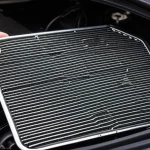Essential Guide to Differential Fluid Changes for Mountain 4WD Performance
Changing your differential fluid regularly is crucial for maintaining peak mountain performance in your 4WD. The differential allows wheels to rotate at different speeds, especially on rugged, uneven terrain. Proper 4WD differential maintenance ensures smooth power transfer and prevents costly damage.
Start by parking the vehicle on a level surface and securely lifting the 4WD. Locate the differential housing, then remove the fill and drain plugs. Drain the old fluid completely, checking for metal particles that could indicate wear. Next, replace the drain plug and refill with the manufacturer-recommended differential fluid to the fill plug level.
Also read : Ultimate guide to installing heat shields: effective strategies to prevent vehicle overheating and keep cool
Differential fluid must withstand high temperatures and heavy loads common in off-road settings. Over time, dirt and debris degrade the fluid’s lubricating properties, increasing friction and wear. Regular changes can prevent overheating and potential failure.
By prioritizing off-road vehicle care and keeping your differential fluid fresh, you enhance reliability and control on challenging mountain trails. This maintenance step ultimately makes your mountain adventures smoother and safer, delivering confidence in every mile.
Topic to read : Optimize your car’s electronic brake system: expert advice on achieving perfect brake force with new brake pads
Choosing the Right Tools, Fluids, and Safety Gear
Selecting the proper differential fluid types is crucial for maintaining your 4WD, especially in demanding mountain or off-road conditions. For rugged use, synthetic gear oils with high viscosity ratings, like 75W-90 or 80W-140, offer superior protection against extreme pressure and temperature fluctuations. These fluids help reduce wear on gear surfaces and resist breakdown caused by harsh environments. Always consult your vehicle’s manual to confirm the suitable fluid type.
When it comes to recommended tools for 4WD maintenance, having the right gear streamlines the process and ensures safety. Essential tools include a quality fluid pump for clean differential fluid extraction and refill, a torque wrench to tighten bolts to manufacturer specifications, and a catch pan to collect old fluids. Additionally, clean rags and a sealant may be necessary for leak prevention.
Safety for fluid changes cannot be overstated. Always perform fluid changes on a stable, level surface and use jack stands to prevent accidents. Wearing gloves and eye protection guards against harmful fluid contact. Proper disposal of used fluids prevents environmental contamination. Prioritizing both the right materials and safe procedures protects you and your vehicle’s longevity.
Expert Tips for Optimal Differential Maintenance
Keeping your drivetrain in top shape
Maintaining the differential is crucial for any 4WD vehicle’s longevity and performance. One expert 4WD tip is to regularly perform differential fluid checks. Inspect the fluid for color and consistency; clean fluid is usually clear or light amber. Dark, gritty, or burnt-smelling fluid signals it’s time for a replacement. Make sure to wipe off the filler plug before opening to prevent contaminants from entering.
Preventative maintenance includes checking for leaks around seals and listening for unusual noises like whining or clunking, which can indicate worn gears or bearings. When tackling these issues, use quality gear oil designed for your model and always drain old fluid completely before refilling to ensure effectiveness.
Scheduling routine maintenance is key. Most manufacturers recommend inspecting and changing differential fluid every 30,000 to 50,000 miles, but harsh driving conditions might require more frequent checks. Keeping a maintenance log can help track your differential’s condition over time, preventing costly repairs later. Following these expert 4WD tips ensures your differential operates smoothly, safeguarding your vehicle’s overall drivetrain health.
Troubleshooting and Solving Common Differential Issues
Understanding 4WD differential problems is essential for maintaining optimal vehicle performance, especially in off-road scenarios. A typical symptom to watch for is unusual noises, such as whining or clunking sounds, which often indicate worn gears or insufficient differential fluid. Low or contaminated fluid can cause irregular wear, affecting the differential’s smooth operation.
Leaks are another common issue. If you notice fluid spots beneath your vehicle, it may signal a seal or gasket failure. Promptly addressing leaks by replacing seals and topping up or changing the differential fluid can prevent extensive damage. Regular inspections of the differential housing and seals help detect problems early.
Troubleshooting requires careful attention to changes in handling or increased resistance when turning. Such signs suggest internal component wear or damage.
If you experience persistent sounds, uneven tire wear, or if the differential fluid appears dirty even after servicing, it is prudent to seek professional help. Complex issues involving gear or bearing failures demand expert diagnosis and repair to restore off-road performance efficiently. Timely intervention safeguards your vehicle’s drivetrain integrity and extends differential lifespan.
Maximizing the Benefits: Transforming Your Off-Road Experience
Upgrading fluid levels and focusing on 4WD performance upgrades are pivotal for enhancing off-road adventures. Fresh gear oil in your transmission and differential provides superior lubrication, significantly improving traction and durability on rough mountain trails. This reduces wear, helping your vehicle tackle steep inclines with more confidence and control.
Long-term vehicle health is directly influenced by regular maintenance and thoughtful performance enhancements. Fluid changes not only protect your differential system but also extend its lifespan by preventing corrosion and heat-related damage. This foresight means fewer breakdowns during critical moments, ensuring your 4WD is ready for countless excursions ahead.
What do real users say about these upgrades? Many report smoother gear shifts and enhanced climbing ability after fluid replacements and system tune-ups. Drivers who have invested in 4WD performance upgrades often describe a noticeable boost in control and a smoother ride over rocky terrain, making mountain adventures more enjoyable and less stressful.
Incorporating these practices transforms your off-road experience, combining peace of mind with enhanced capability. Consistent attention to your vehicle’s mechanical health is the key to maximizing both performance and safety.
Understanding Precision and Recall in SQuAD Evaluations
In the context of the Stanford Question Answering Dataset (SQuAD), precision and recall are crucial metrics for assessing the performance of machine learning models. Precision measures the proportion of tokens in the predicted answer that are correct, specifically calculated as:
Precision TP / (TP + FP). Here, TP (true positives) represents the number of tokens shared between the predicted answer and the correct answer, while FP (false positives) counts tokens incorrectly included in the prediction but absent from the correct answer.
Conversely, recall evaluates how much of the correct answer is captured by the prediction:
Recall TP / (TP + FN), where FN (false negatives) denotes the number of tokens in the correct answer that the prediction misses.
The balance between precision and recall sheds light on model accuracy in identifying the relevant answer span. High precision with low recall means the model is precise but misses parts of the answer, while high recall with low precision indicates it covers the correct answer extensively but includes irrelevant tokens.
By analyzing these metrics quantitatively, researchers and engineers can pinpoint strengths and weaknesses in their question-answering systems and guide improvements toward more accurate, efficient responses.


